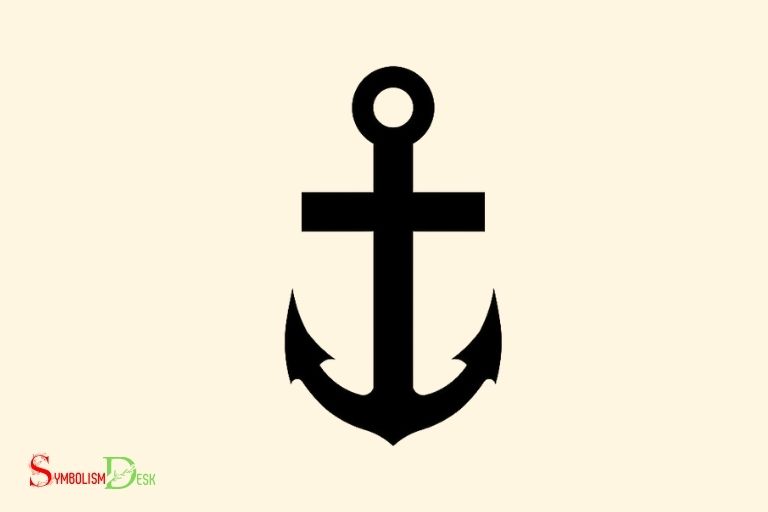What Does the Anchor Symbol Mean in Christianity? Stability!
In Christianity, the anchor symbol represents hope, stability, and faithfulness, signifying the strong connection Christians have with God.
The anchor symbol has been used since the early days of Christianity to represent hope and faith, as it was often seen as a symbol of safety and security for sailors navigating the seas.
The anchor also stands for the unwavering commitment that Christians have to their faith, as it keeps them grounded and steadfast in their belief in Jesus Christ.
The anchor symbol has played an essential role in Christian art, serving as a constant reminder of the hope and faith that Christians have in their relationship with God.
During times of adversity and doubt, the anchor serves as a powerful symbol of the unbreakable bond between God and His followers, ensuring that they remain steadfast in their beliefs no matter the challenges they face.
5 Interpretations of the Anchor Symbol in Christianity
| Anchor Symbol | Aspect | Christian Meaning |
|---|---|---|
| ⚓ | Hope | The anchor serves as a symbol of hope, as it holds firm and steady even in stormy seas, just as the Christian faith keeps believers steadfast in their trust in God. |
| ⚓ | Stability | The anchor represents stability and a strong foundation in Christianity, symbolizing the unshakable faith that believers hold in God and Jesus Christ as the cornerstone. |
| ⚓ | Security | The anchor is a symbol of security, reminding Christians of the promise that God will never abandon them and will always keep them safe through good times and adversity. |
| ⚓ | Cross Reference | The anchor is often depicted with a cross shape, representing the crucifixion of Jesus Christ and his resurrection, which serves as the foundation of the Christian faith. |
| ⚓ | Early Christians | The anchor was used by early Christians as a covert symbol of Christianity to avoid persecution, drawing on the metaphor of Jesus as the anchor of their faith. |
Key Takeaway

Five Facts About: The Anchor Symbol in Christianity
The Origin Of The Anchor Symbol In Christianity
The anchor is a symbol of faith and hope in christianity. It has been used for centuries and has a rich history that dates back to the early christian period.
In this section, we’ll explore the historical context of the symbol, how it’s related to the apostles, and the significance of the anchor in the early church.
Historical Context Of The Symbol:
- The symbol of the anchor is primarily associated with maritime culture. In ancient times, anchors provided a sense of security to sailors, and they came to represent steadfastness and stability.
- When christianity emerged in the first century, the anchor became a popular symbol of faith and hope. At the time, christians were faced with persecution and other hardships, the anchor served as a reminder that their faith was steadfast and could weather any storm.
- The anchor is also associated with the stoic philosophy of the time, which emphasized the importance of being steadfast in the face of adversity. The stoics believed that an anchor could provide a sense of stability and security in the midst of turmoil and uncertainty.
How The Symbol Is Related To The Apostles:
- The anchor symbol is closely connected to the apostles, particularly saint peter and saint andrew. According to christian tradition, both saints were fishermen before they became disciples of jesus christ.
- The anchor is associated with saint peter because he was called by jesus to be a “fisher of men.” Saint peter’s faith was unwavering, just like the anchor that keeps a ship secure in a storm.
- Saint andrew is also associated with the anchor symbol. Legend has it that he was crucified on an x-shaped cross, which is also known as a saint andrew’s cross. The cross is often depicted with an anchor because andrew was a fisherman and the anchor served as a symbol of his former occupation.
Significance Of The Anchor In The Early Church:
- In the early church, the anchor symbolized the hope that christians had in christ. The anchor was a sign of the christian’s faith, which was anchored firmly in god’s promises.
- The anchor was also associated with the christian virtue of hope, which was considered to be an essential element in the life of a believer. The anchor symbolized the hope that believers had for eternal life in heaven.
- The anchor became a popular symbol in early christian art and was often depicted alongside other symbols of the faith, such as the cross and the fish.
The anchor symbol in christianity has a rich history that dates back to the early christian period. It symbolizes the steadfastness of faith and the hope that believers have in christ. Understanding biblical symbolism is important in interpreting the meaning of the anchor in Christianity. The anchor also represents the idea of salvation and the connection between God and humanity. The use of the anchor as a symbol can be found in the New Testament, particularly in the Book of Hebrews, further emphasizing its significance in the Christian faith.
The anchor’s association with saint peter and saint andrew underscores its significance in the christian faith.
Christians continue to find comfort and joy in the symbol as a reminder of their unwavering faith in god’s promises.
The Symbolism Of The Anchor In Christianity
The anchor is a widely recognized symbol in christianity, representing hope and steadfastness. It has been an important emblem for the christian community for centuries, both as a symbolic artifact and as a metaphorical representation.
In this section, we will explore the symbolism of the anchor in christianity, with a focus on its representation of hope, biblical references, and how the anchor relates to faith.
Representation Of Hope And Steadfastness
- The anchor symbolizes hope and steadfastness because, just as an anchor secures a ship so it won’t drift away, hope and faith secure christians and keep them from being swept away by the tumultuous waves of life.
- The hope that christians have in god, who is steadier than any anchor and who has made promises that will not be broken, is what anchors them in tough times.
- The anchor thus serves as a reminder that in moments of difficulty, christians can remain anchored through their belief in the promises of god.
Biblical References To The Anchor
- The anchor has strong biblical roots. The book of hebrews in the new testament refers to the anchor as a symbol of hope: “we have this hope as an anchor for the soul, firm and secure” (hebrews 6:19).
- The anchor is also referenced in acts 27: 29, where paul’s ship was tossed about in a storm, and they had to drop four anchors to keep from being shipwrecked.
- These references highlight the anchor’s significance as a symbol that represents the hope and faith that christians have in god.
How The Anchor Relates To Faith In Christianity
- The anchor serves as a reminder of the security and safety that christians have in their faith.
- In times of doubt and upheaval, the anchor of faith reminds christians to hold fast to god’s promises and to trust in him.
- The anchor is also associated with christ, who is called the “anchor of the soul” in the book of hebrews. Christ is seen as the ultimate anchor, the one who provides unwavering hope and security to those who believe in him.
The anchor is a powerful and important symbol in christianity, representing hope, steadfastness, and faith. It is a reminder that even in challenging times, christians can remain anchored through their trust in god’s promises.
Usage Of The Anchor Symbol In Christianity
The anchor symbol is commonly used in christianity as a representation of faith, hope, and safety in christ. Its significance can be seen in various aspects of the christian faith, from art and architecture to worship.
Its Use In Christian Art And Architecture
The early christians used the anchor symbol in their artwork, primarily in the roman catacombs.
This symbol was often used in conjunction with a fish, which was an essential early christian symbol.
Some of the main uses of the anchor symbol in christian art and architecture are:
- Depicting jesus as an anchor: Jesus christ is often portrayed as an anchor that holds us steadfast through tumultuous storms. The anchor is a powerful symbol of security and significance in christ.
- As a symbol of st. clement: St. clement was an early christian martyr who was thrown into the sea with an anchor tied to his neck. This event became an essential part of clementine history, and the anchor symbol is used in many of his depictions.
- As a symbol of hope: The anchor symbolizes hope for christians, something that is echoed by hebrews 6:19, “we have this hope as an anchor for the soul, firm, and secure.”
The Anchor As A Symbol Of Salvation
The anchor is a potent symbol of salvation in christianity as it symbolizes security, stability, and hope. The anchor represents christ’s faithfulness and permanence in our lives and reminds us that we are anchored to him.
The anchor symbolizes the following:
- Security: The anchor provides safety and security, which is what christ offers us. He holds us firm and steady, providing us with a sure foundation and security in him.
- Perseverance: The anchor also symbolizes perseverance, reminding us to remain steadfast in our faith in christ, even in the face of adversity.
- Hope: The anchor is a symbol of hope, a reminder that we have a future with christ.
How The Symbol Is Integrated Into Christian Worship
The anchor symbol is integrated into various aspects of christian worship. The anchor can be used as a visual representation of scripture passages, such as hebrews 6:19, which talks about hope being an anchor for the soul.
The anchor can also be used in the following ways during christian worship:
- Decorations: Churches may use the anchor symbol as a decoration in their interiors, such as in stained-glass windows.
- Music: The anchor symbol can be incorporated into christian music, such as hymns, and contemporary worship songs.
- Sermons: The anchor can be used as a visual representation during sermons, teaching the importance of hope, faith, and salvation in christ.
The anchor symbol holds significant meaning in christianity as a symbol of faith, hope, and salvation. Its usage can be seen in christian art and architecture, symbolizing salvation, and its integration into christian worship.
Furthermore, the anchor symbol remains a powerful reminder to christians of the security and hope they have in christ.
The Anchor Cross
The anchor cross is a symbol in christianity that represents hope. It is a combination of the anchor symbol and the cross symbol, two powerful christian symbols.
In this section, we will delve into the definition and the origin of the anchor cross, its relation to christianity, and why it represents hope.
Definition And Origin Of The Anchor Cross
The concept of a ‘hopeful anchor’ comes from the new testament book of hebrews 6:19, which describes hope as an anchor for the soul.
The anchor cross is a combination of the anchor and the cross, signifying the anchoring power of jesus’ sacrifice on the cross.
The anchor cross is also known as the mariner’s cross, symbolizing how sailors used the anchor to hold their ships steady amidst the stormy sea.
Relation Of The Anchor Cross To Christianity
In christianity, the anchor symbolizes safety and hope. The cross is a symbol of jesus’ sacrifice, representing god’s love for humanity.
The anchor cross combines both these symbols, reinforcing the idea that the cross is where we find spiritual safety and the hope of eternal life.
The anchor cross is often used in christian art and jewelry to represent one’s trust in god’s unshakeable faithfulness.
Why The Anchor Cross Is Seen As A Symbol Of Hope In Christianity
The anchor cross symbolizes hope because it reminds believers that they can keep their faith anchored in christ.
Just as a physical anchor keeps a ship steady, the anchor cross reminds christians to cling to christ amidst the turbulence of life.
It also signifies that god is a source of stability in times of trouble. The anchor cross is a powerful reminder that even amidst the strongest storms, hope endures.
Is the symbolism of the Hestia symbol similar to the anchor symbol in Christianity?
The hestia symbol meaning is not similar to the anchor symbol in Christianity. While the anchor symbol represents stability and hope, the hestia symbol represents the Greek goddess of hearth and home. It signifies warmth, hospitality, and the importance of family. These symbols hold distinct meanings in their respective contexts.
FAQ About What Does The Anchor Symbol Mean In Christianity
What Does The Anchor Symbol Represent In Christianity?
The anchor symbol represents faith, hope, and steadfastness in god’s promises and salvation.
Why Is The Anchor Symbol Important In Christianity?
The anchor symbol is important in christianity because it represents the unshakable and steadfast foundation of faith in jesus christ.
What Is The History Of The Anchor Symbol In Christianity?
The anchor symbol has its roots in the early christian church where it was used as a disguised symbol of the cross and represented salvation.
Is The Anchor Symbol Used In Other Religions Besides Christianity?
Yes, the anchor symbol has been used in other religions such as ancient greek and roman mythology where it was associated with their sea gods.
How Can The Anchor Symbol Be Used In Christian Everyday Life?
The anchor symbol can be used as a reminder of the unchanging nature of god’s promises, a symbol of hope in difficult times and a token of faith in jesus christ.
Conclusion
As we conclude our exploration of the anchor symbol in christianity, it is clear that this image has a profound meaning for believers.
The anchor represents hope, stability, and trust in god’s promises. In times of turbulence and uncertainty, the symbol can bring comfort and remind us to hold firm to our faith.
However, it is essential to note that the anchor is not a substitute for believing in jesus christ.
Instead, it serves as a visual reminder of the steadfastness of our savior. As we sail through the storms of life, may we hold fast to the anchor of hope that is found in christ alone.
May the symbol of the anchor lead us to the one who says, “i am the way, the truth, and the life. No one comes to the father except through me” (john 14:6).






